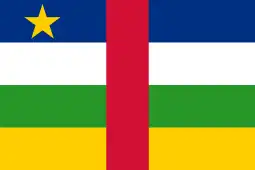| |||||
| Decades: |
| ||||
|---|---|---|---|---|---|
| See also: | Other events of 2013 History of the Central African Republic | ||||
The following lists events that happened during 2013 in the Central African Republic.
Incumbents
- President: François Bozizé (until 24 March), Michel Djotodia (starting 25 March)
- Prime minister: Faustin-Archange Touadéra (until 17 January), Nicolas Tiangaye (starting 17 January)
Events
January
- 2 January - Séléka rebels halt their advance on the capital of Bangui and agreed to peace talks.[1] However, President Bozizé fires his army chief of staff and son as defence minister to take the ministry administration himself.[2]
- 6 January - South Africa announces plans to deploy 400 more soldiers into the Central African Republic to assist President Bozizé against the Séléka rebels.[3]
- 11 January - The government signs a ceasefire with the rebels ending the conflict and establish a coalition government.[4]
March
- 23 March - All UN personnel are withdrawn from the Central African Republic as Séléka rebels move in to capture Bangui.[5]
- 24 March - The Séléka rebels take the presidential palace. Bozizé flees to the neighboring Democratic Republic of the Congo.[6]
- 25 March - Michel Djotodia declares himself as President of the Central African Republic and promises to keep to the agreement of power-sharing and end looting.[7] South African President Jacob Zuma claims 13 of his country's soldiers were killed in the conflict.[8]
- 26 March - President Djotodia suspends the constitution and dissolves the parliament.[9]
April
- 4 April - South Africa announces the full withdrawal of troops from the Central African Republic.[10]
September
- 9 September - 60 people are killed during clashes between Séléka forces and supporters of former president Bozizé.[11]
October
- 9 October - 60 people are killed in clashes between former Séléka forces and local militias.[12]
November
December
- 5 December - The United Nations approves a peacekeeping mission to be sent to the country led by the African Union and France due to recent clashes seeing more than 100 people killed.[14]
- 6 December - The Red Cross claims that over 300 people have been killed in two days of fighting in the capital of Bangui.[15]
- 7 December - France extends its role in the conflict by deploying 1600 troops to aid the peacekeepers.[16]
- 10 December - Two French troops are killed in clashes in Bangui, the first French casualties since the deployment of 1600 troops.[17]
- 26 December - 40 people including six Chadian peacekeepers are killed in clashes in the country.[18]
References
- ↑ "Central African Republic rebels halt advance, agree to peace talks".
- ↑ "CAR President Fires Defense Minister, Army Chief".
- ↑ "South Africa boosts presence in Central African Republic".
- ↑ "Central African Republic ceasefire signed".
- ↑ "UN pulls staff as CAR rebels threaten capital".
- ↑ "Central African Republic: President Bozize flees Bangui".
- ↑ "CAR president seeks refuge in Cameroon".
- ↑ "Jacob Zuma: 13 South African soldiers killed in CAR".
- ↑ "CAR rebel head Michel Djotodia 'suspends constitution'".
- ↑ "South Africa to withdraw troops from CAR".
- ↑ "Central African Republic says scores killed in new clashes".
- ↑ "Around 60 dead in clashes in Central African Republic".
- ↑ "France to Boost Central African Republic Forces Amid 'Chaos'".
- ↑ "France vows immediate action in Central African Republic after battle".
- ↑ "'Hundreds dead' in Central African Republic violence".
- ↑ "Central African Republic: French troops expand operations".
- ↑ "French soldiers killed in Central African Republic".
- ↑ "CAR unrest kills dozens, including six Chad peacekeepers".
This article is issued from Wikipedia. The text is licensed under Creative Commons - Attribution - Sharealike. Additional terms may apply for the media files.
